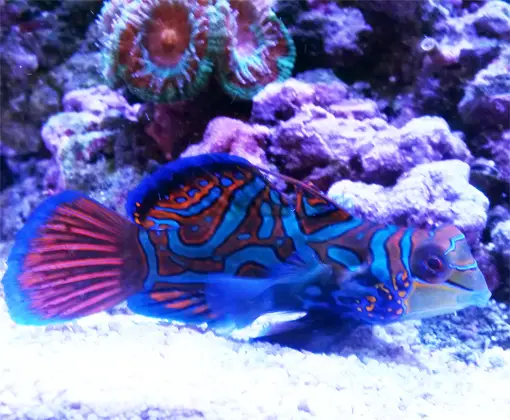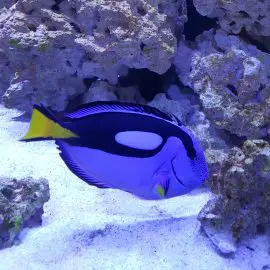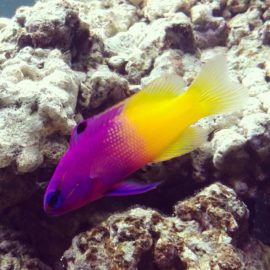Dosing Phytoplankton in a Saltwater Aquarium
If you’re wondering whether or not you should be dosing phytoplankton in your saltwater tank, read on!

Should I dose phytoplankton in my saltwater tank?
When replicating the ocean in an aquarium, there are initially no phytoplankton present in the water. The main reason for this is that the water used in our saltwater aquariums is filtered through a multi-filtering process, resulting in clean RODI water. Even ordinary tap water is chemically treated and would kill any living organisms within it. (If you’re interested, you can read this article on why you shouldn’t use tap water for your saltwater aquarium.)
If you have a fish only tank then their dietary needs are met when you feed them. But what if you have coral or other filter feeders? Examples of filter feeders are clams, sponges, oysters, etc.
Generally speaking, coral can survive without phytoplankton dosing, but you don’t just want coral to survive, you want them to thrive! Coral will be brighter, plumper and healthier looking. I great place to buy phytoplankton is from AlgaeBarn, available at Amazon.
- Seed Your Aquarium & Feed Finicky Fish
- Contains nutritious Tigriopus & Tisbe Copepods plus 4 strains of live phytoplankton
- Premium live food for Mandarin Dragonets, Seahorses, LPS, SPS & NPS Corals, Wrasses, Anthias, Pipefish, Clown Fish, Blennies, Clams, & other Finicky Fish & Inverts
Phytoplankton is the beginning of the food chain in the ocean, it is beneficial in a saltwater aquarium in that it feeds copepods, and amphipods. These zooplankton in turn consume organic waste in the water such as bacteria and detritus. Phytoplankton therefore, indirectly helps to keep your aquarium free of unwanted algae and keeps the water in the reef aquarium clean.
Slow movers like the Mandarin goby rely heavily on copepod (zooplankton) which feed off phytoplankton. (This is why they are not generally recommended for beginners to saltwater aquariums. They need a constant supply of zooplankton like copepods, rotifers and brine shrimp in order to survive.)
What are phytoplankton?
Phytoplankton as microalgae. Examples of other microalgae found in the saltwater hobby are cyanobacteria, green algae, diatoms1 and dinoflagellates. None of which you want in your tank. If you are a beginner to saltwater aquariums then I am sure you will have already heard or at least read about these already!
Microalgae are tiny organisms that are so small they cannot be seen individually with the naked eye unless looked at through a microscope. Talking of microscopes, I found this handy little microscope to take a closer look at dinoflagellates in my tank, using your phone to take videos. Anyhow … microalgae use energy from the sun (photosynthesis) by turning carbon dioxide into glucose which is imperative to growth2.
Thankfully phytoplankton do not fall into the pest bracket. In fact, phytoplankton are used as a defence against pest algae. Check this article on Dinoflagellates. As members at the bottom of the food chain phytoplankton provide nutrition for all aquatic life either directly or indirectly3. Zooplankton, such as rotifers and copepods, feed off phytoplankton and in turn, fish and invertebrates feed off the zooplankton.
Do corals need phytoplankton?
Corals in the ocean feed on dissolved minerals and proteins. They are helped by Zooxanthellae, which are actually a type of dinoflagellate. The zooxanthellae and coral have a symbiotic relationship. They live on the coral polyps and through photosynthesis, provide the coral with the majority of what it needs to grow.
But this is just one way in which coral is fed. The other is the coral polyps themselves. At night, they extend their tentacles to reach out and grab zooplankton. And what do zooplankton feed on? Phytoplankton!
So, do coral in saltwater tanks need phytoplankton to grow? No, not if they are getting enough of the correct lighting so the zooxanthellae can make food. But by adding phytoplankton, you are feeding the zooplankton which in turn feed the coral and this will offer a well rounded diet for coral.
Can you add too much phytoplankton?
Yes! The last thing you want is to add too much phytoplankton and cause a spike in algae growth.
If you think that dosing might be increasing the algae in your aquarium, you can use your test kits to test your phosphate and nitrate levels. Phytoplankton also adds phosphates and nitrates to the tank and for this reason it is best to test for these before adding phytoplankton.
Here is a really interesting video on phytoplankton.
How to dose phytoplankton
Always follow the instructions on the bottle if purchasing phytoplankton from a store or online supplier. Below though, are a few tips and things to keep in mind when dosing phytoplankton in your reef aquarium.
Dose at night with the lighting turned off. Some corals, such as bubble coral and candy canes are LPS and tend to extend their tentacles at night searching for food. Not all coral feed at night though so this can be left up to the individual. Soft corals such as mushrooms, zoa and green star polyp close up after dark so would benefit from daytime phytoplankton dosing.
If you plan on feeding phytoplankton to your coral or clams you can use a coral feeder to feed directly.
Turn off your skimmer while you dose phytoplankton. Not only might your skimmer go nuts, but it can remove the phytoplankton from the water column.
Turn off your UV sterilizer, as any phytoplankton pumped through your UV will be killed.
Phytoplankton should be kept in the refrigerator in order to keep it fresh. Make sure to shake the contents before not only putting them in your tank but every other day so that the phytoplankton does not sink to the bottom of the bottle and die.
Store bought phytoplankton usually has a shelf life of approximately 6 weeks so you need to take a note of when you purchased it and discard after that time. I have heard that you can also freeze any that you know you will not be using within 6 weeks although I have not personally tried this.
What eats phytoplankton in a reef tank?
As mentioned above, phytoplankton is consumed by various zooplankton such as copepods and amphipods, as well as other filter feeders. Filter feeders include sponges, clams and some coral.
So there you have it!
I’d definitely recommend dosing phytoplankton, especially if you have an active copepod population and corals. Not only will your fish be happier but you coral with thrive.






